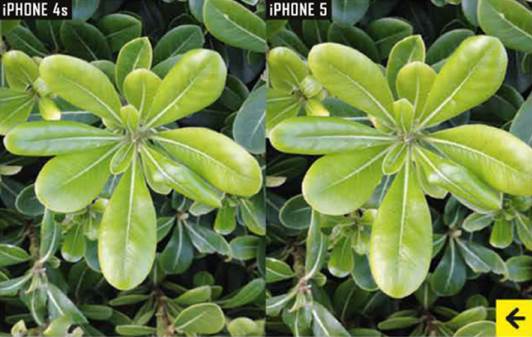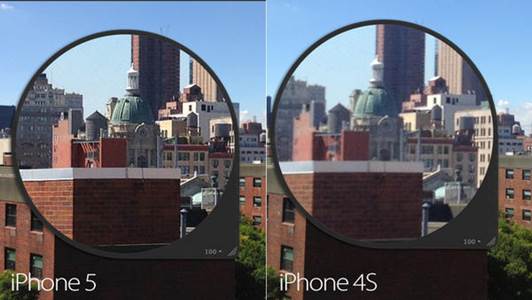The new iPhone 5 has the best camera
in an iPhone yet. We compare it with its acclaimed predecessor
What's all the hullabaloo, it's only a
phone, right? Well yes, but the Apple iPhone 5 is no ordinary phone, it’s the
latest incarnation of what’s widely regarded as the best smartphone on the
market, and the overwhelming phone of choice among photographers. (Although it
only accounts for 18.8% of the global market, for example, two out of the top
three most popular cameras on Flickr are iPhones.)

The
iPhone 4S won our camera phone group test last year and its successor performs
just as well, producing great looking images
The iPhone 5 improves upon the 4s in almost
every way. First the obvious the phone has retained the same width but
stretched in length to accommodate a 4in screen with a 16:9 ratio (from a 3.5in
4:3 ratio). Although it has the same resolution (326ppi) the screen appears
sharper and more saturated thanks to changes in the design which have enabled
the layer of touch sensitive electrodes that previously sat above the pixels to
be built into the pixels themselves. As well as boosting the screen’s clarity
this has also helped make the phone thinner just 7.6mm while the switch from a
glass back and steel frame to an anodized aluminium casing has trimmed the
weight from 140g to 112g, despite its larger size a difference that feels
greater in the hand than it seems on paper.
The camera
The iPhone 5 has a newly designed sensor
but retains the same 8MP resolution, and has a new sapphire crystal outer lens,
added more for scratch resistance than any gain in optical quality. The big
improvement though is the speed, thanks to the new A6 processor which is twice
as fast as the A5. This offers many benefits, from gaming to web browsing, but
it also enables the camera to be activated more quickly, and images to be
captured, edited, saved and shared more rapidly.
Apple has also added several functional
photography improvements. It has boosted the top ISO from 100 to 32000 (though
you can’t select this manually), and the front camera is now HS, so self-portraits
and FaceTime chats look better. There’s a new panorama mode which produces
instant 2400 images by sweeping the phone in an arc a feature found
on some cameras. Video recordings benefit from some enhancements too. The image
stabilization has been beefed up to make recordings smoother, while the
addition of an extra rear-facing mic provides better sound than having to use
the phone mic, which faces the wrong way for video. Also users can now take
1920 x 1080 pixel still images during video recording a great feature for
anyone who has agonized over whether to shoot stills or video of junior’s
school sports day sack race.
The iPhone 5’s wider screen is of little
benefit for stills photography, since images are still captured in the 4:3
ratio (unless you use one of the third-party apps that offers different aspect
ratios). It does, however, help when viewing panoramas, and of course when
shooting HD video.

In
addition, the front-facing camera on the iPhone 5 takes much better
Image quality
The camera module in the iPhone 5 may be
different from the one in the 4s but it behaves in an almost identical way.
Using both cameras side by side the images are virtually indistinguishable in
normal conditions, and even indoors. Sharpness and detail are excellent while
exposures are generally spot on, with punchy but not unnatural colors. In extremely
low light though (such as candlelight) it’s a different story. The iPhone 5
still produces usable if noisy images with recognizable shadow detail in
conditions when the 4s fails to capture any image at all.

In
good light images from the iPhone 4s and iPhone 5 are virtually
indistinguishable in quality

The
iPhone 5’s higher maximum ISO of 3200 and better noise reduction pays dividends
in very low light levels
Verdict
There was a huge leap in photo quality
between the iPhone 4 and the 4s, but from the 4s to the iPhone 5 the changes
are more subtle and incremental and some of them (such as the panorama mode)
can be added to earlier models by downloading iOS 6. Otherwise the only gains
are operational speed and better performance in very low light. Video users
will gain more from upgrading, particularly in being able to make use of a
screen that’s now the right aspect ratio for full screen viewing.
Main camera improvements over the iPhone
4S
·
Faster processor
·
Sapphire crystal lens cover
·
Higher max ISO (to ISO 3200)
·
Improved low light performance
·
Shoot stills and video simultaneously
·
Panorama mode (available on earlier models with
iOS 6)
·
HD front-facing camera (for self-portraits etc)
Other reasons to upgrade to the iPhone 5
·
Lighter, thinner (yet stronger)
·
Bigger, brighter 16:9 screen
·
Faster at everything
·
Better Wi-Fi (N), faster 3G/4G
·
Much better headphones (new design)